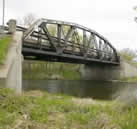Streamlining Studies
Over the past two decades, the MnDOT Cultural Resources Unit has worked with the FHWA, the State Historic Preservation Office, and the Office of the State Archaeologist to help streamline Section 106 reviews. Part of this effort has been the development of context studies that provide benchmarks for evaluating the historical significance of commonly encountered property types. Other streamlining initiatives include a uniform field protocol to use in testing for deeply buried archaeological resources and a GIS-based archaeological predictive model. Many of these initiatives have been used by other federal and state agencies and their funding recipients to help streamline their own Section 106 processes.
MnModel Statewide Archaeological Predictive Model
MnModel is a set of GIS data that help MnDOT avoid impacts to archaeological resources throughout Minnesota. The data are developed using GIS-based raster and statistical modeling procedures. The final product of this process is a map of the potential for pre-1837 surface archaeological sites in Minnesota, which helps plan needed archaeological survey efforts.
Woodland Tradition in Minnesota (MPDF)
This MPDF addresses the historic resources associated with the Woodland tradition in the state of Minnesota, spanning the period from 1000 B.C. to A.D.1750. The documentation presents general information about Minnesota's environment and resources, the history of archaeological research in Minnesota, the precontact traditions defined for the state, and research themes applicable to all Woodland complexes. The study outlines the property types associated with this period as well as guidelines for evaluating the National Register of Historic Places eligibility of these resources.
Deep Sites Testing Protocol
The Deep Test Protocol Project developed a cost-effective field protocol for discovering deeply buried archaeological sites.

Historic Bridges in Minnesota
There are over 200 bridges in Minnesota that have been identified as 'historic' (i.e., eligible for listing in the National Register of Historic Places). As part of the effort to understand and preserve these important historic properties, MnDOT developed a historic bridge website that details a variety of information about Minnesota's historic bridges.
Historic Trunk Highways in Minnesota, 1920-1973
Minnesota is home to over 200 Trunk Highways and a handful of those are historic, or considered eligible for listing in the National Register of Historic Places. MnDOT developed a historic roads website to share the history of the development of the trunk highway system and those significant segments of the state’s road system.
Minnesota Farms, 1820-1960
This context study was completed to help MnDOT and the State Historic Preservation Office determine which historic farm resources meet the eligibility criteria of the National Register of Historic Places, a benchmark of significance for federal agencies and their funding recipients. This study also helped MnDOT make better-informed decisions as it seeks ways to avoid, reduce, and mitigate potential adverse effects to significant historic properties.
Railroads in Minnesota, 1862-1956 (MPDF)
The MnDOT CRU developed this National Register of Historic Places Multiple Property Documentation Form (MPDF) that examines the historical significance of railroad corridors in Minnesota. The MPDF provides guidelines for evaluating the National Register of Historic Places eligibility of the state's railroad-related properties. The documentation includes two reports: (1) expanding information in the MPDF regarding the study's methodology and constraints; and (2) applying the criteria developed in the MPDF to evaluate the National Register eligibility of four railroad corridors.
Historic Roadside Structures on Minnesota Highways
In the 1990s, MnDOT conducted a statewide inventory of its roadside features on state highways to identify properties that were eligible for the National Register of Historic Places. Roughly half of the 110 properties were determined to be eligible. Most of these were built during the 1930s and early '40s by unemployed Minnesotans under the federal relief programs of President Roosevelt's New Deal and today are landmarks important to regional tourism services. They include features such as scenic overlook walls, picnic tables and fireplaces, interpretive markers, and small bridges. MnDOT has prepared roadside facilities management plans for many of the facilities to provide preservation direction to MnDOT when planning transportation improvements near these resources.

